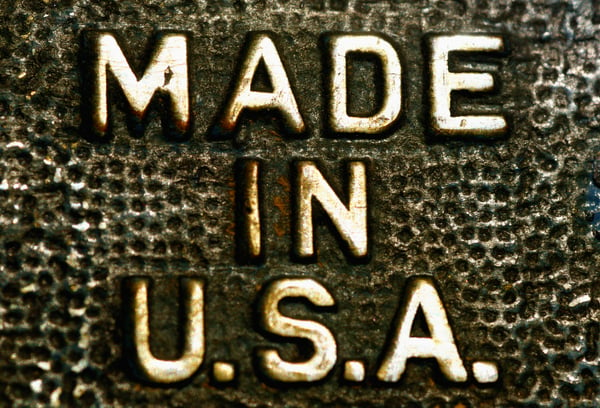This article written by Adam Robinson originally appeared on the Cerasis blog on October 28, 2015
In today's post, we feature a great infographic below from a joint report byDeloitte Manufacturingandthe Manufacturing Institute. Before featuring this information so that manufacturers understand how the public views them, let's first go through a brief history of the American Manufacturing Industry by highlighting some moments & inventions that changed the way of life as we know it.

A Brief Timeline of American Manufacturing Industry Moments & Innovations
The following is a timeline of key American Manufacturing Industry Moments & Innovations up to present day.The purpose of this timeline is to show how manufacturing has evolved over time.
1785: Beginning of Modern Bulk Material Handling
An automatic flour mill is built by Oliver Evans and uses a leather belt bucket elevator, screw conveyors, belt conveyors, and other devices.
1801: Eli Whitney Demonstrates Interchangeable Parts
Whitney owed the US government 10,000 contracted muskets and needed a quick way to produce them.
1820: US Industrial Revolution Begins
Coal power and machine production change the world.
1830: 1st American Steam Locomotive Completed
The "Tom Thumb" raced a horse-drawn cart to prove the superior power of steam engines.
1850: American System of Manufacturing
The American System of Manufacturing becomes popular.Interchangeable parts and mechanization galore.
1908: First Car Manufacturing in the United States
The first Model T rolls off the assembly line.It cost $850 and was only offered in black.
1913: 1st Moving Assembly Line
Ford installs the first moving assembly line.
1930s: Lean Manufacturing
Toyota begins developing "Just-in-Time (JIT)" manufacturing and the "automation." These concepts become widely adopted in the 1990s as Lean Manufacturing.
1942: Jet Engines Developed
In the year that began the start of America's involvement in World War II, jet engines were developed.In 1942, a group of GE engineers, known as "The Hush-Hush Boys," working non-stop for ten months built America's first jet engine.
1947: International Organization for Standardization Founded
ISO is founded to develop international standards for business and technology.
1953: First CAD Software Created
The digital computer was used in 1953 with built-in computer operations to automatically coordinate transforms to compute radar related vectors and the essentially graphic mathematical process of forming a shape with a digital machine tool.These were accomplished with the use of computer software.The man credited with coining the term CAD was Douglas T.Ross.
1954: First Commercial Silicon Transistor & First Programming Language
On May 10, 1954, Texas Instruments announces availability of commercial transistors.Also in 1954, IBM introduced the first programming language called FORTRAN.Derived from Formula Translating System, FORTRAN is a general-purpose, imperative programming language that is especially suited to numeric computation and scientific computing.
1958: Integrated Circuits, or "Chips" Developed
In 1958, the introduction of integrated circuits allowed a higher level of processing laying the groundwork for more industrial automation.
1960s: The Development and Use of Overall Equipment Effectiveness (OEE)
Overall equipment effectiveness (OEE) is a hierarchy of metrics developed by Seiichi Nakajima in the 1960s to evaluate how effectively a manufacturing operation is utilized.It is based on the Harrington Emerson way of thinking regarding labor efficiency.The results are stated in a generic form which allows comparison between manufacturing units in differing industries.
1970: The Occupational Safety and Health Act (OSHA) Introduced
OSHA standards around safety and health in the American workplace, and primarily in the American Manufacturing industry are developed and put in place.This ushers in a focus on safety in manufacturing.
1973: Industrial Robots Introduced
ABB Robotics and KUKA Robotics introduce industrial robots to the European market and they are quickly adopted in the US.You can read a more detailed timeline of the history of robotics here.
1979: The Peak of American Manufacturing Industry Employment
Employment in the American manufacturing industry peaked in the United States in 1979, according to data published by the Bureau of Labor Statistics.
1980s: Smart Cameras are Developed
Character, date and code verification performed by cameras and machine vision systems for manufacturing begin development.
1981: The First PC Introduced
With the introduction of the first personal computer. The IBM Personal Computer, commonly known as the IBM PC, is the original version and progenitor of the IBM PC compatible hardware platform.It is IBM model number 5150, and was introduced on August 12, 1981.It was created by a team of engineers and designers under the direction of Don Estridge of the IBM Entry Systems Division in Boca Raton, Florida.
The consumer rise of the use of computers powers the ubiquity of using computers in industrial manufacturing and the B2B space at large.This adds more efficiency to the workplace and more manufacturing competition.
1981: Six Sigma Developed by Motorola
The quality system seeks to remove defects and minimize errors.This strategy became famous in 1995 when Jack Welch implemented it at GE.
1983: Patent for RFID Tags Secured
In 1983, Charles Walton first patented RFID or radio frequency identification technology.Unfortunately for him, his latest patent about RFID expired in the mid-1990s.So he will not make any money from the billions of RFID tags that will appear in the years to come.
2000s: Skid Mounted Design of Process Systems Becomes Popular
Skid-mounted process systems allow you to bypass the challenges of onsite fabrication of systems including support and utility components.
Off-site fabrication of a process system helps ensure that fabrication tasks do not lead to costly plant interruptions.A plant is also not forced to accommodate extra staff.Site-specific training and Good Manufacturing Practices (GMP) likewise become lesser concerns.
2002: U.S.Manufacturing Enterprise Integration Act of 2002
The U.S.Manufacturing Enterprise Integration Act of 2002 was enacted to develop the foundations for a Smart Manufacturing infrastructure and approach.
2007: The first iPhone is released By Apple
With the introduction of the first iPhone, the era of mobility in manufacturing begins, allowing for more efficient communications on the plant floor and laying the groundwork for the future of manufacturing to go digital.
2012: The Rise of Robotics Use in Manufacturing
With companies like Rethink Robotics introducing robotics such as Baxter and the ability to combine technology with gestures, a whole new era of automation in manufacturing begins.
2013: 3D Printing Taking Hold In Manufacturing
The earliest 3D printing technologies first became visible in the late 1980's, at which time they were called Rapid Prototyping (RP) technologies. 2013 was a year of significant growth and consolidation.One of the most notable moves was the acquisition of Makerbot by Stratasys.
2014 to today and beyond: The Rise of Industry 4.0
Heralded as the 2nd, 3rd and, sometimes even, 4th Industrial Revolution by some, what cannot be denied is the impact that 3D printing is having on the industrial sector and the huge potential that 3D printing is demonstrating for the future of consumers.What shape that potential will take is still unfolding before us.When we combine such other sweeping technologies like the Internet of Things and big data, the state of theAmerican ManufacturingIndustry is truly on the cusp and evolution of a public perception change.
Infographic: The Public Perception of the American Manufacturing Industry
So, what is the current perception of the American Manufacturing Industry? U.S.economic recovery and job creation continue to be important concerns for many Americans.The American public continues to show very strong support for manufacturing and a deep understanding of the economic benefits that result from a vibrant manufacturing sector.Yet, Americans continue to have mixed views regarding the future of manufacturing in the U.S.

Reshoring Trends eBook
Gain a better understanding of reshoring, its role in the past, present, and future!
Download our eBook, "Trends, Projections and Benefits of Reshoring." Inside we cover:
- Download our eBook, "Trends, Projections and Benefits of Reshoring." Inside we cover:
- Historical background & projections on offshoring & reshoring
- Factors to consider when deciding if reshoring is right for your business
Click the image below to make larger.









Comments